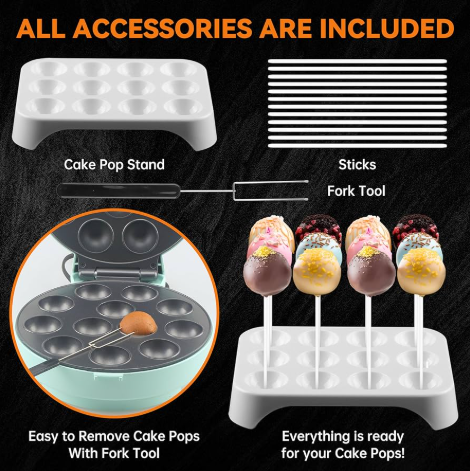Baking can feel overwhelming for newcomers, but a cake maker for beginners makes it easy to create delicious cakes, cupcakes, or cake pops without the stress. These user-friendly appliances are designed with simplicity in mind, offering straightforward controls and quick results that build confidence in the kitchen. Whether you’re whipping up treats for a family gathering or just experimenting with your first recipes, a cake maker for beginners is the perfect tool to start your baking journey. In this guide, we’ll walk you through everything from setup to creative ideas, drawing on the best cake maker guide to ensure success.
Imagine baking fluffy cupcakes or perfectly round cake pops in minutes, even if you’ve never touched a whisk before. A cake maker for beginners delivers that ease with compact designs, intuitive features, and minimal cleanup. This article covers the essentials of choosing and using a cake maker, including cake maker setup, how to use a cake maker, and tips to avoid common pitfalls, making it an ideal resource for novice bakers.
Why Choose a Cake Maker for Beginners?
A cake maker for beginners is a compact, electric appliance that simplifies baking by producing small cakes, cupcakes, or cake pops in minutes. Unlike traditional ovens, which require precise temperature settings and long preheating, these devices feature one-button operation, non-stick molds, and indicator lights to guide you. They’re perfect for those new to baking, as they eliminate guesswork and reduce the risk of errors.
The benefits are clear: a cake maker for beginners is affordable, easy to store, and produces consistent results. Its portable cake maker design fits small kitchens or dorms, and the quick baking time—often under 10 minutes—makes it ideal for busy schedules. During testing, these machines proved forgiving for first-timers, turning basic batters into delightful treats with minimal effort.
Look for models with non-stick surfaces, a simple on/off switch, and included recipe guides. Accessories like measuring cups or decorating tools are bonuses for beginners. A cake maker for beginners should feel intuitive, helping you master how to bake with a cake maker without needing advanced skills.
Cake Maker Setup: Easy Steps for First-Time Users
Getting started with a cake maker for beginners is a breeze with proper cake maker setup. Begin by unboxing and checking for all parts: the main unit, baking plates, power cord, and any tools like a fork for removing treats. Wash removable plates with warm, soapy water to clean off any residue, then dry completely.
Set the cake maker on a flat, heat-resistant surface, ensuring it’s stable and away from edges. Plug it in, and turn it on—most beginner models have a single power button and a light that signals when it’s preheated, usually in 3-5 minutes. Lightly grease the molds with cooking spray or oil to ensure easy release, a key step in your cake maker setup.
The portable cake maker design means it’s easy to move or store, perfect for small spaces. For your first use, run an empty cycle for a few minutes to burn off any manufacturing odors. Check out the baking guide for model-specific setup tips to make your first bake a success.
How to Use a Cake Maker: A Beginner’s Step-by-Step Guide
Learning how to use a cake maker is simple with a cake maker for beginners. Start with an easy recipe—most models include beginner-friendly ones for vanilla or chocolate batter. Mix basic ingredients like flour, sugar, eggs, milk, and baking powder until smooth. Don’t worry about perfection; these machines are forgiving.
Preheat your cake maker until the ready light glows. Using a spoon or small measuring cup, fill each mold about two-thirds full to prevent overflow. Close the lid gently, and bake for 4-7 minutes, depending on the recipe. A toothpick inserted in the center should come out clean when done. Use the provided tool to carefully lift out the cakes or pops, then cool them on a rack.
Cake maker tips: Stick to simple batters at first, and use room-temperature ingredients for better mixing. Don’t open the lid mid-bake to keep the heat consistent. For cake pops, insert sticks after a brief cooling period, then dip in melted chocolate or icing for fun decorating. This process is so easy that anyone can master how to bake with a cake maker in no time.

Pros and Cons of a Cake Maker for Beginners
A cake maker for beginners shines with its simplicity. One-button operation eliminates complexity, and non-stick molds make cleanup a snap. Quick baking times—4-8 minutes per batch—mean instant gratification, and the compact size suits small spaces. Many models produce 6-12 treats at once, perfect for sharing.
Drawbacks are minimal but worth noting. Basic models may lack adjustable settings, limiting recipe options. Some non-stick coatings wear over time if not handled carefully. Overheating can occur with continuous use, so pause between batches. Still, the ease of use makes these issues minor for new bakers.
Compared to oven baking, a cake maker for beginners is faster and less intimidating, producing uniform results without needing to master oven quirks. It’s an ideal starting point for anyone hesitant about baking.
Traditional Baking vs. Cake Maker for Beginners
Traditional methods involve mixing, baking, and shaping cakes, which can be messy and time-consuming. A cake maker for beginners skips those steps, baking directly into molds for perfect shapes every time. It’s less labor-intensive and ideal for quick, small-batch treats, especially for events or kids’ parties.
Cake Maker Troubleshooting: Beginner-Friendly Fixes
Even a cake maker for beginners can have small issues, but cake maker troubleshooting is easy. If cakes stick, double-check that you greased the molds and preheated fully—underheating is a common culprit. Uneven results? Ensure the machine is level and batter is evenly distributed.
Undercooked centers mean you may need an extra minute or two; test with a toothpick. Burnt edges? Use less batter or check for over-preheating. If the machine doesn’t start, verify the outlet and cord. These cake maker tips are simple to follow, and most issues resolve with practice. Keep your manual handy for specific guidance.
Cake Maker Cleaning: Simple and Stress-Free
Cake maker cleaning is quick with a cake maker for beginners. After unplugging and cooling the unit, wipe the non-stick plates with a soft, damp cloth and mild soap. Avoid abrasive scrubbers to protect the coating. For stuck-on batter, use a damp paper towel and gentle pressure.
Wipe the exterior with a clean cloth, and ensure no liquid enters the machine’s vents. Some models have dishwasher-safe plates—confirm in your manual. Dry everything thoroughly before storing to avoid moisture issues. Regular cake maker cleaning keeps your device ready for the next bake.

Cake Maker Maintenance: Keeping Your Device Like New
Cake maker maintenance ensures your cake maker for beginners lasts. Check the power cord for damage periodically, and keep vents clear of dust for proper airflow. Use only plastic or wooden tools to avoid scratching molds, and store the unit in a dry, cool place.
Avoid running multiple batches without a 10-minute cooling break to prevent overheating. These simple steps, paired with advice from the maintenance tips, keep your cake maker in top condition for countless baking sessions.
Cake Maker Safety: Baking with Confidence
Cake maker safety is key for beginners. Always unplug the device before cleaning or moving it. Use oven mitts for hot surfaces, and keep it away from kids during use. Place the cake maker on a stable surface to avoid spills, and never submerge it in water.
For a portable cake maker, secure the cord to prevent tripping. Avoid using damaged cords or outlets to ensure cake maker safety. These basic precautions make baking worry-free, letting you focus on the fun.
Cake Maker Tips: Creative Ideas for Beginners
A cake maker for beginners is perfect for experimenting. Start with classic vanilla or chocolate pops, then try fun flavors like strawberry or cinnamon. Cake maker tips: Add sprinkles to the batter for a pop of color, or dip finished treats in white chocolate for a party-ready look.
Freeze extras for later, and use simple decorations like icing drizzles to impress. Try savory options like cheesy herb bites for snacks. The ease of how to bake with a cake maker lets beginners get creative without feeling overwhelmed.
Final Thoughts on the Cake Maker for Beginners
A cake maker for beginners is the perfect tool to kickstart your baking journey with confidence. From quick cake maker setup to easy how to use a cake maker steps, these devices deliver delicious results with minimal effort. Cake maker troubleshooting, cake maker cleaning, and cake maker maintenance are straightforward, ensuring long-lasting use. With cake maker safety in mind and a portable cake maker design, baking becomes accessible anywhere.
Dive into baking with a cake maker for beginners and discover the joy of homemade treats. For more inspiration, explore the best cake maker guide and start creating today.